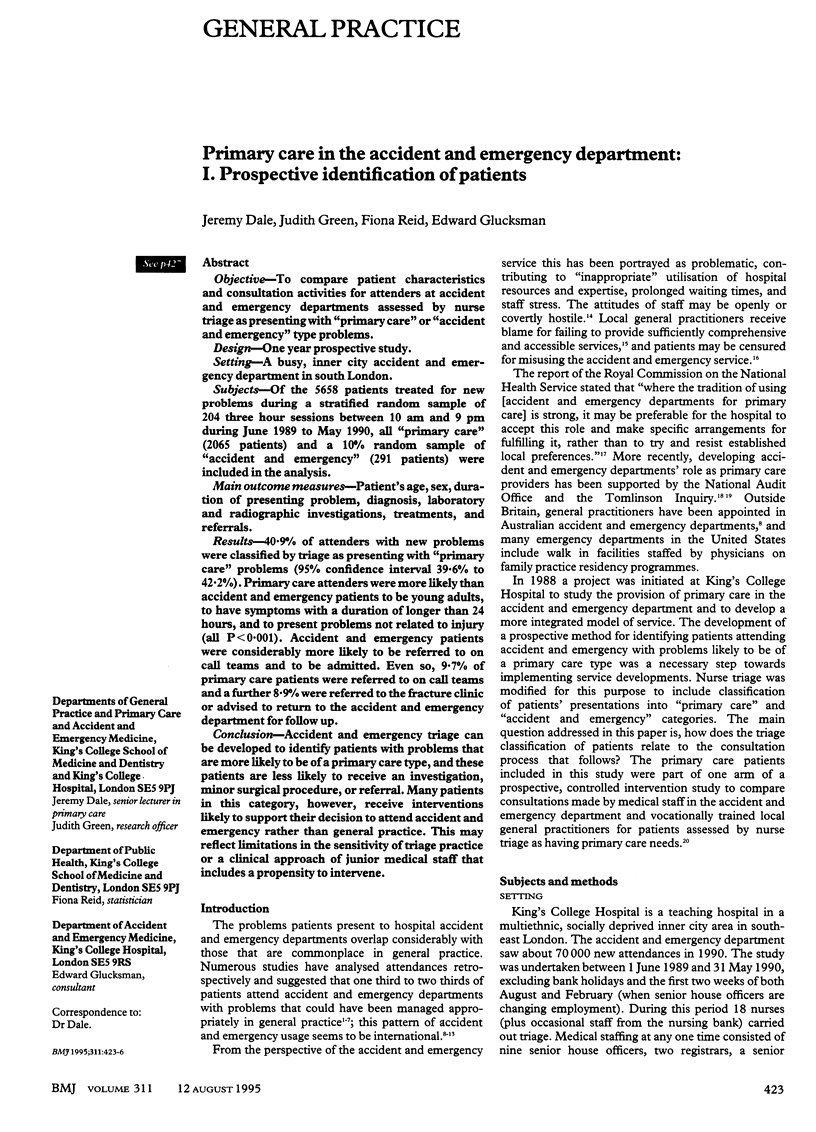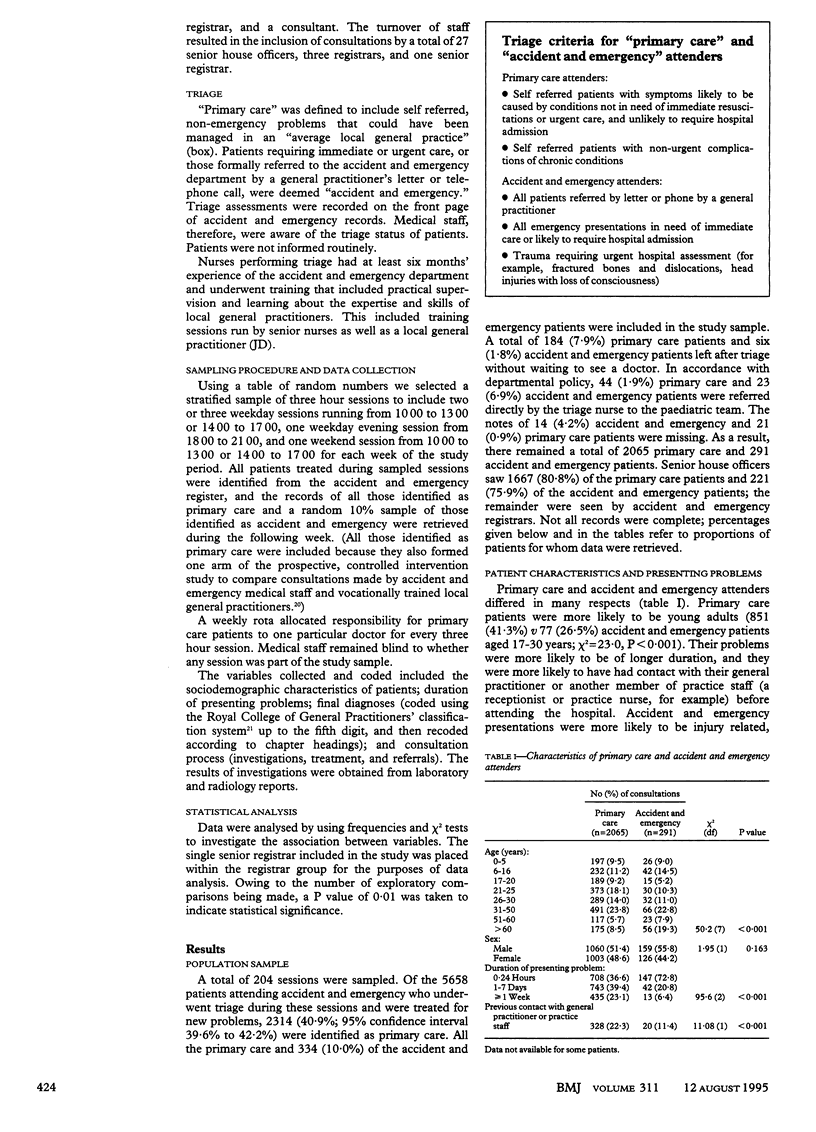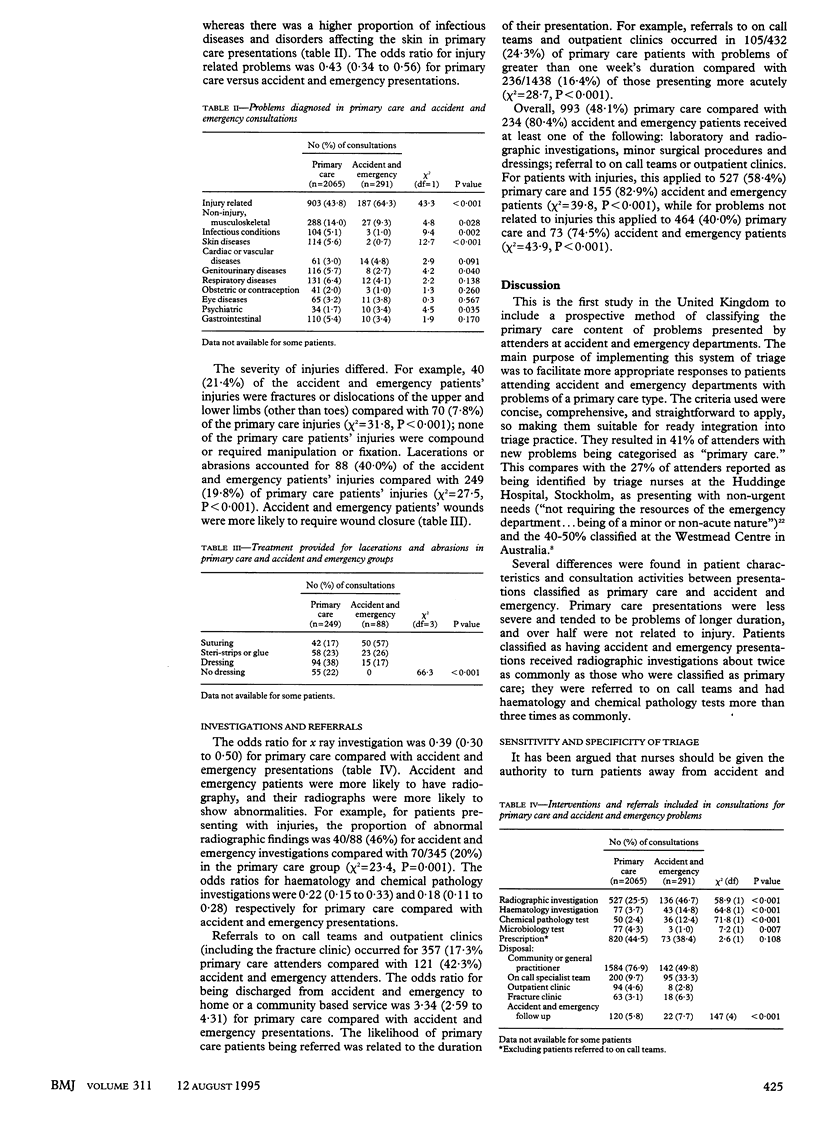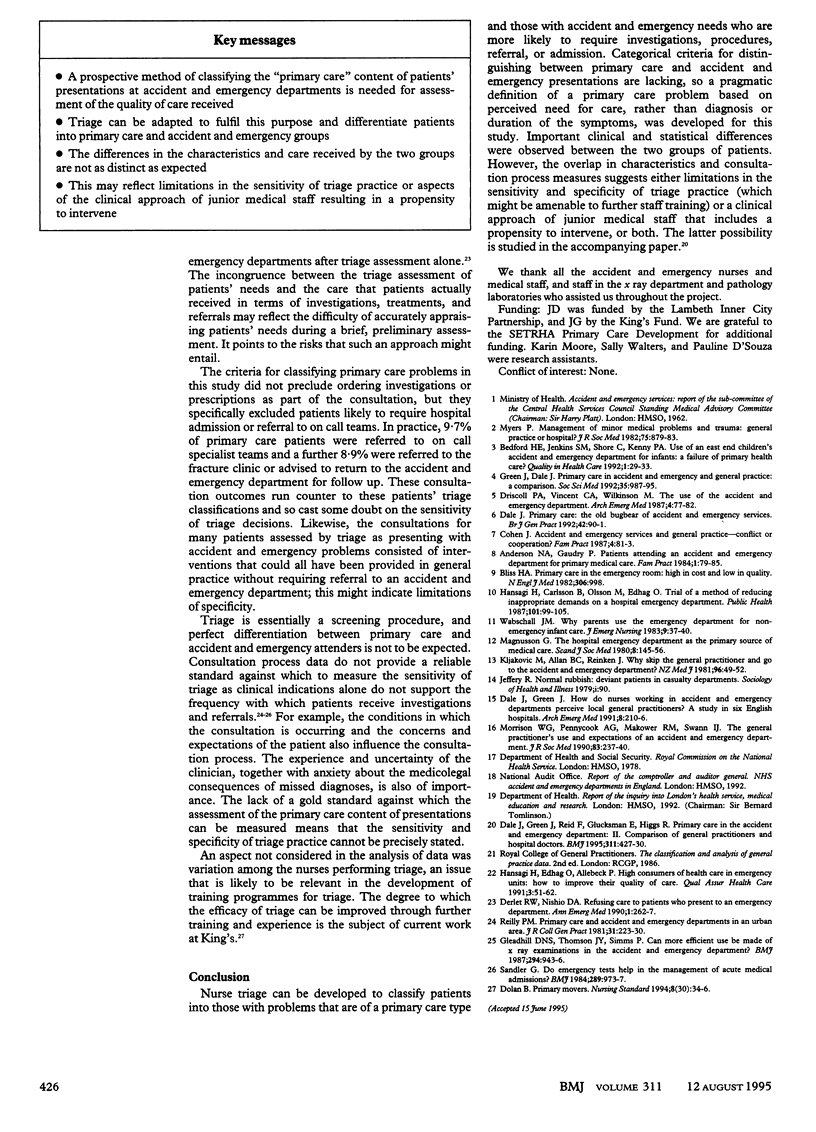Abstract
OBJECTIVE--To compare patient characteristics and consultation activities for attenders at accident and emergency departments assessed by nurse triage as presenting with "primary care" or "accident and emergency" type problems. DESIGN--One year prospective study. SETTING--A busy, inner city accident and emergency department in south London. SUBJECTS--Of the 5658 patients treated for new problems during a stratified random sample of 204 three hour sessions between 10 am and 9 pm during June 1989 to May 1990, all "primary care" (2065 patients) and a 10% random sample of "accident and emergency" (291 patients) were included in the analysis. MAIN OUTCOME MEASURES--Patient's age, sex, duration of presenting problem, diagnosis, laboratory and radiographic investigations, treatments, and referrals. RESULTS--40.9% of attenders with new problems were classified by triage as presenting with "primary care" problems (95% confidence interval 39.6% to 42.2%). Primary care attenders were more likely than accident and emergency patients to be young adults, to have symptoms with a duration of longer than 24 hours, and to present problems not related to injury (all P < 0.001). Accident and emergency patients were considerably more likely to be referred to on call teams and to be admitted. Even so, 9.7% of primary care patients were referred to on call teams and a further 8.9% were referred to the fracture clinic or advised to return to the accident and emergency department for follow up. CONCLUSION--Accident and emergency triage can be developed to identify patients with problems that are more likely to be of a primary care type, and these patients are less likely to receive an investigation, minor surgical procedure, or referral. Many patients in this category, however, receive interventions likely to support their decision to attend accident and emergency rather than general practice. This may reflect limitations in the sensitivity of triage practice or a clinical approach of junior medical staff that includes a propensity to intervene.
Full text
PDF



Selected References
These references are in PubMed. This may not be the complete list of references from this article.
- Andersen N. A., Gaudry P. L. Patients attending an accident and emergency department for primary medical care. Fam Pract. 1984 Jun;1(2):79–85. doi: 10.1093/fampra/1.2.79. [DOI] [PubMed] [Google Scholar]
- Bedford H. E., Jenkins S. M., Shore C., Kenny P. A. Use of an east end children's accident and emergency department for infants: a failure of primary health care? Qual Health Care. 1992 Mar;1(1):29–33. doi: 10.1136/qshc.1.1.29. [DOI] [PMC free article] [PubMed] [Google Scholar]
- Bliss H. A. Primary care in the emergency room: high in cost and low in quality. N Engl J Med. 1982 Apr 22;306(16):998–998. doi: 10.1056/nejm198204223061626. [DOI] [PubMed] [Google Scholar]
- Cohen J. Accident and emergency services and general practice--conflict or cooperation? Fam Pract. 1987 Jun;4(2):81–83. doi: 10.1093/fampra/4.2.81. [DOI] [PubMed] [Google Scholar]
- Dale J., Green J. How do nurses working in hospital accident and emergency departments perceive local general practitioners? A study in six English hospitals. Arch Emerg Med. 1991 Sep;8(3):210–216. doi: 10.1136/emj.8.3.210. [DOI] [PMC free article] [PubMed] [Google Scholar]
- Dale J., Green J., Reid F., Glucksman E., Higgs R. Primary care in the accident and emergency department: II. Comparison of general practitioners and hospital doctors. BMJ. 1995 Aug 12;311(7002):427–430. doi: 10.1136/bmj.311.7002.427. [DOI] [PMC free article] [PubMed] [Google Scholar]
- Derlet R. W., Nishio D. A. Refusing care to patients who present to an emergency department. Ann Emerg Med. 1990 Mar;19(3):262–267. doi: 10.1016/s0196-0644(05)82041-4. [DOI] [PubMed] [Google Scholar]
- Dolan B. Accident and emergency: primary movers. Nurs Stand. 1994 Apr 20;8(30):34–36. doi: 10.7748/ns.8.30.34.s33. [DOI] [PubMed] [Google Scholar]
- Driscoll P. A., Vincent C. A., Wilkinson M. The use of the accident and emergency department. Arch Emerg Med. 1987 Jun;4(2):77–82. doi: 10.1136/emj.4.2.77. [DOI] [PMC free article] [PubMed] [Google Scholar]
- Gleadhill D. N., Thomson J. Y., Simms P. Can more efficient use be made of x ray examinations in the accident and emergency department? Br Med J (Clin Res Ed) 1987 Apr 11;294(6577):943–947. doi: 10.1136/bmj.294.6577.943. [DOI] [PMC free article] [PubMed] [Google Scholar]
- Green J., Dale J. Primary care in accident and emergency and general practice: a comparison. Soc Sci Med. 1992 Oct;35(8):987–995. doi: 10.1016/0277-9536(92)90238-l. [DOI] [PubMed] [Google Scholar]
- Hansagi H., Carlsson B., Olsson M., Edhag O. Trial of a method of reducing inappropriate demands on a hospital emergency department. Public Health. 1987 Mar;101(2):99–105. doi: 10.1016/s0033-3506(87)80046-x. [DOI] [PubMed] [Google Scholar]
- Hansagi H., Edhag O., Allebeck P. High consumers of health care in emergency units: how to improve their quality of care. Qual Assur Health Care. 1991;3(1):51–62. doi: 10.1093/intqhc/3.1.51. [DOI] [PubMed] [Google Scholar]
- Jeffery R. Normal rubbish: deviant patients in casualty departments. Sociol Health Illn. 1979 Jun;1(1):90–107. doi: 10.1111/1467-9566.ep11006793. [DOI] [PubMed] [Google Scholar]
- Kljakovic M., Allan B. C., Reinken J. Why skip the general practitioner and go to the accident and emergency department? N Z Med J. 1981 Jul 22;94(688):49–52. [PubMed] [Google Scholar]
- Morrison W. G., Pennycook A. G., Makower R. M., Swann I. J. The general practitioner's use and expectations of an accident and emergency department. J R Soc Med. 1990 Apr;83(4):237–240. doi: 10.1177/014107689008300412. [DOI] [PMC free article] [PubMed] [Google Scholar]
- Myers P. Management of minor medical problems and trauma: general practice or hospital? J R Soc Med. 1982 Nov;75(11):879–883. doi: 10.1177/014107688207501111. [DOI] [PMC free article] [PubMed] [Google Scholar]
- Reilly P. M. Primary care and accident and emergency departments in an urban area. J R Coll Gen Pract. 1981 Apr;31(225):223–230. [PMC free article] [PubMed] [Google Scholar]
- Sandler G. Do emergency tests help in the management of acute medical admissions? Br Med J (Clin Res Ed) 1984 Oct 13;289(6450):973–977. doi: 10.1136/bmj.289.6450.973. [DOI] [PMC free article] [PubMed] [Google Scholar]
- Wabschall J. M. Why parents use the emergency department for nonemergency infant care. J Emerg Nurs. 1983 Jan-Feb;9(1):37–40. [PubMed] [Google Scholar]


